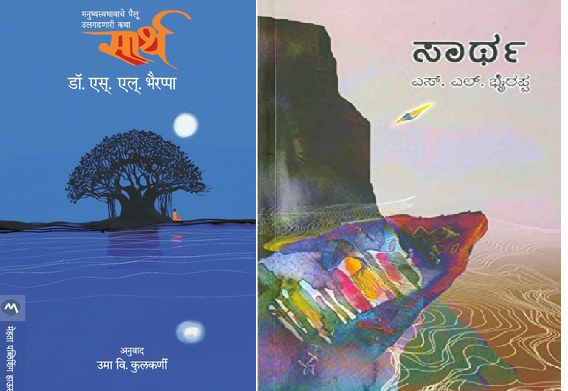
After reading SL Bhyrappa’s Parva I wanted to read more from the man. I started with Saartha after a friend recommended it. Review of Parva.
Saartha is a tale of a Brahmana sent on a mission by his king under the pretext of finding more about the various trade caravan routes with a Saartha (caravan). The protagonist Naga-Bhatta is the first person narrator for the entire book. The novel is primarily a journey of self realization of Naga-Bhatta – dealing with a varied range of emotions from anger, infidelity, love to melancholy and despondency. Naga-Bhatta travels from his hometown in Central India to North Indian plains – particularly Mathura, from Mathura to Kannauj and Kannauj to Magadha, Magadha to Mahismati before embarking upon a journey to Arab ruled Multan before coming back to Mathura. Though a lot of characters come and go in the novel, the ones who leave a mark as personalities apart from Nagabhatta are Pratihara Senapati JaySingh and actress and Yogini Chandrika. Other than that, the author also brings the real life historic personalities to life in fantastic and powerful manner. – Mandana Misra, Kumarila Bhatta, Bharati Devi (Misra) and epoch changing Adi-Shankaracharya. Apart from that, the author deals with the intellectual fights – especially between Sramanas (especially Bauddhas) and the followers of the Vaidika Dharma (Vedic Hindus). Bhyrappa manages critical about aspects of both the traditions even though the narration is that of a Vaidika Brahmana.
The storytelling is top notch and visually perfect. The dialogues are extremely effective and powerful. But where the author excels like in Parva is bringing to life a real world from a time long gone. What is more – he manages to do it with the Zeitgeist of the story in mind – not our own. The author doesn’t want to be politically correct or use his zeitgeist as a lens to observe the events of the tale. As the narration is that of a moderately patriarchal 8th century Brahmana, he doesn’t try to bring up the hypocrisy of his position – wherein the protagonist has no qualms about his (attempted) infidelity while he cannot digest his wife’s betrayal so much that it derails his life – filing him up with despondency and emptiness. Its in moments like these that the brilliance of the author comes through.
Throughout the narrative we are come across various spiritual paths available to the thinkers and philosophers in Ancient India – namely the Karma Kanda focused Vaidika Mimansa path, the Mahayana Bauddha path, the Yoga path, the Tantrik path, and finally Shankara’s Advaita. How the Naga-Bhatta grabbles with these paths and how he finds his Karma at the end is essentially the story of novel, Alchemist like tale with huge dollops of sophisticated philosophy and realism. What is fascinating about this book is that unlike Parva (Mahabharat) this book deals with and uses supernatural powers not just as sidenotes but for important parts of the story arc. Also the author’s grasp over Sanskrit is just spectacular, and like in Parva he has created couplets here and there as per the plot demand.
the Polemic and the Philosophy: (Spoilers ahead)
While the story of Saartha works on various levels, I doubt if that was the main purpose of the book. The author uses the character arc of Naga-Bhatta around which the tapestry of 8th Century India is painted, and its this tapestry that works more than the story. In the beginning we are introduced to the conflicts and divergences between Vaidika and Bauddha traditions, while noting the important changes which were occurring in the Bauddha tradition during this time. Some scholars have pointed to these changes (adopting of Puranic deities and tales) which made the Bauddha traditions loose its differentiating USP. The portrayal of Drama as a means of spread of devotional traditions of Rama and Krishna is fantastic. The mechanisms of Yoga and especially Tantra are very well explored. The flirtation of Naga-Bhatta with Buddhism, his abandoning of Vaidika traditions and coming back are not only explained convincingly, but readers also given a peak into the potential origins of the Maithuna images (erotic coupling images) which adorn the Khajurao temples.
The first climax of the book – based on the hagiography of Shankara- deals with the encounter of Adi-Shankara with the Guru of Naga-Bhatta – Mandana Misra, and though Mandana Misra is said to lose that encounter personally as I reader I couldn’t follow the logic of it. Similarly the peek into the life of Kumarila Bhatta – the Mimansika who is said to have defeated the Buddhists before Shankara left me unsatisfied. However one has to note that maybe that was the desire of the author, who clearly seems to favor the Vaidika Mimansikas (minus some orthodoxy).
The final climax of the book is about the confrontation with Islam. This part felt slightly caricaturish but still captured some of the salient reasons for Islamic incursions into the subcontinent. The tripartite struggle of Palas, Prathirahas and Rashtrakutas, the Hindu insularity and naivety & superstition and various other reasons come forth during the climax. The book ends on a very sour note, but that wasn’t surprising, as Bhyrappa is no bollywood screenwriter (who make Padvawat and Panipat appear as victories of Hindus (maybe even Prithviraj)).
Incidentally the History podcast Brownpundits have been producing was covering the same time period which Saartha covers. I would highly recommend the book to anyone interested in history, philosophy or even self discovery – Saartha works very well on all these fronts.
Personally as an agnostic I have wondered why have I never been attracted to the philosophy of Buddha whereas I have always been attracted by the philosophies’ Vaidika and Puranic Dharma. Bhyarappa was able to give me the answer in one sentence “Can you imagine Buddha saying what Krishna says (on Kurukshetra) ?”
